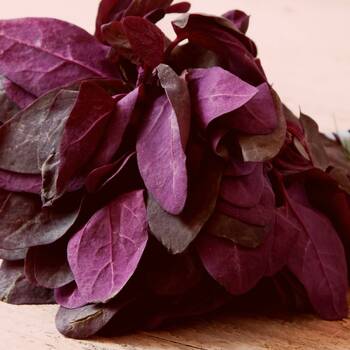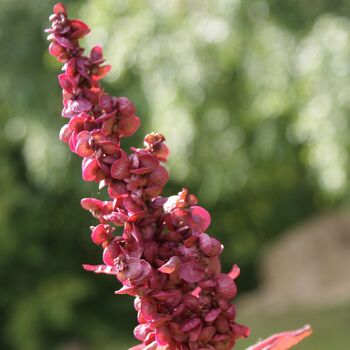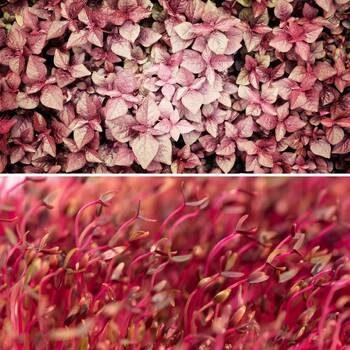
How to Grow Orach Seeds
Grow Guide #2446
Family: Amaranthaceae
Binomial name: Aptriplex hortensis
Life Cycle: Annual
This 'How to Grow' guide details everything a home gardener needs to know to plant, grow and care for Orach (Aptriplex hortensis).
When to Sow Orach Seeds
Orach is a warm season crop. Use the table below to identify the best time of year to sow orach seeds in your climate.
| JAN | FEB | MAR | APR | MAY | JUN | JUL | AUG | SEP | OCT | NOV | DEC | |
|---|---|---|---|---|---|---|---|---|---|---|---|---|
| Cool | ||||||||||||
| Temperate | ||||||||||||
| Sub-Tropical | ||||||||||||
| Tropical | ||||||||||||
| Arid |
Preparation
Orach plants commonly self-seed in the garden. Self-seeding plants drop seeds onto the soil at the end of the season that may germinate and grow without help the following season. Choose a position where new plants will be welcome. If you do not want orach to become established in your garden, deadhead plants before they can drop seed or grow them in containers.
Orach plants are best grown in full sun or part shade. Choose a location that will receive at least 3 hours of full sun each day.
Orach plants need a well drained soil enriched with plenty of organic matter. Prepare soil by weeding it thoroughly, digging it over to loosen it and adding aged animal manure or compost. Keep the area free of weeds until planting. Learn more about preparing soil for planting here.
Orach plants can be grown in containers. If possible choose a variety that’s recommended for container growing. Use a good quality potting mix and make sure your container is large enough for mature plants; a minimum of 10 litres is recommended for orach. During the growing season, keep in mind that container grown plants may need additional fertiliser to encourage healthy growth.
How to Sow Orach Seeds
Orach seeds do not require any treatment (eg soaking, stratification) before sowing.
Orach seeds grow best when they are sown directly into the garden.
- Sow seeds directly in the garden 2mm deep and 40cm apart, with rows 50cm apart.
- Keep soil moist but never wet or dry.
- Seeds should germinate in around 7-14 days at a soil temperature of 20-22°C.
- Young seedlings will need protection from pests, pets and weather until they are established.
Tip: Orach seeds can also be sown in the less formal ‘scatter seed’ method. Simply roughen the soil, scatter seeds evenly over the surface, then smooth the soil over lightly to cover the seeds.
How to Grow Orach
Orach plants may need watering during the growing season. Water when the soil is dry about 5cm below the surface (test this by scratching away a little soil with your finger). Water deeply in the early morning or late afternoon. Avoid watering the leaves of plants to avoid fungal diseases. Learn more about watering here.
If soil was well prepared no extra fertiliser should be necessary. In poor soil or to give your plants an extra boost, application of a high-nitrogen fertiliser or one formulated for leafy greens or herbs can be beneficial:
- Apply slow release fertiliser at the recommended rate when transplanting or when seedlings are 5-10cm tall.
- Apply liquid fertiliser at the recommended rate and frequency during the growing season.
Optional: To give plants room to grow, thin seedlings when they are large enough to handle. Pull out any weak or small seedlings so plants are spaced about 40cm apart.
Pinch out the growing tips of orach plants to encourage denser growth and the development of new, tender leaves. Using sharp secateurs or snips remove the top set of leaves, cutting just above a set of lower leaves.
How to Harvest Orach
Orach can be grown as a vegetable for its spinach-like leaves, for its edible seeds, or as a 'filler' in cut flower bouquets.
Orach leaves should be ready to harvest in approximately 50 days.
Leaves are ready to harvest when they are large enough to eat, and can be harvested as needed. Harvest leaves by pinching off the outer leaves, leaving some on the plant for future growth. Alternatively, whole plants can be harvested by cutting the stems at ground level. Orach is best eaten soon after it is harvested. Leaves can be stored short term in a perforated plastic bag in the fridge.
Orach seeds should be ready to harvest in approximately 75-100 days.
To harvest the seeds, allow the plant to grow and form seed heads and the seeds to dry on the plant. Remove individual seeds from the plant by hand. Seeds can be ground into flour or added to soups, stews, bread or cereals. Store seeds in an airtight container in a dry, cool place.
To harvest orach as a cut flower, use sharp snips or secateurs to cut long stems of foliage early in the season, or wait until the plants have formed seed heads and cut stems while the seeds are fresh. Remove the lower leaves and place the stems immediately in a clean bucket of water.
Common Problems when Growing Orach
Like all plants, orach is susceptible to some pests, diseases and other problems. Below is a list of the most common problems gardeners encounter when growing orach plants:
 Aphids are small (2-4mm long) sap-sucking insects that congregate on the new shoots or the undersides of leaves. They can cause leaves to wilt or become discoloured, and also excrete honeydew which can attract ants and other insect pests. To manage aphids, remove them by spraying with a garden hose, apply a soap or alcohol spray, or encourage predatory insects to your garden. Read more about aphids here.
Aphids are small (2-4mm long) sap-sucking insects that congregate on the new shoots or the undersides of leaves. They can cause leaves to wilt or become discoloured, and also excrete honeydew which can attract ants and other insect pests. To manage aphids, remove them by spraying with a garden hose, apply a soap or alcohol spray, or encourage predatory insects to your garden. Read more about aphids here.


.png)





